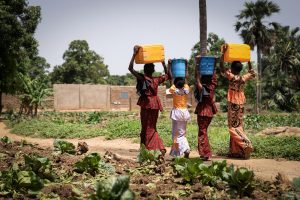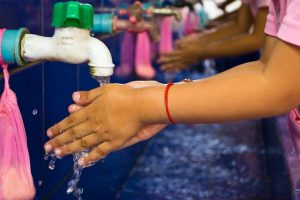Good water management helps smallholders improve their diets and incomes
With less than a decade left to achieve the 17 Sustainable Development Goals (SDGs), the prospects look worrying for several of them. Covid-19 has made it even harder to make progress on for example SDG 1 and SDG 2 – to end poverty and hunger – and the situation is similar for SDG 6 about clean water, sanitation, and water efficiency.

These challenges are however closely linked, and they should be addressed through a coordinated response. The FAO, the Food and Agriculture Organization of the United Nations, has joined forces with SIWI to expand the knowledge on “nutritional water productivity” where the idea is to produce crops that provide higher nutritional value than today in a water-efficient manner.
SIWI’s Senior Scientific Advisor Professor Jan Lundqvist has led research to test the ideas behind the concept, in collaboration with the Swedish University of Agricultural Sciences, FAO and the Policy Studies Institute in Addis Ababa.
The result is presented in the new FAO discussion paper Water productivity, the yield gap, and nutrition – The case of Ethiopia, written by Jan Lundqvist, Louise Malmquist, Paulo Dias, Jennie Barron and Mekkonnen Wakeyo.
Though the focus is on Ethiopia, the main lessons are valid and applicable in many parts of the world, Jan Lundqvist believes.
“Securing access to nutritious food and water for various human needs is one of our greatest challenges. In a world with rising temperatures, more extreme weather events, and more erratic rainfall patterns, this will not be easy. But improved water management, coordinated with other relevant arrangements, can bring both improved health and larger yields. We all need to learn to do things differently.”
It is crucial to understand the relationships between food, nutrition, health, people’s livelihoods and agriculture. All these components and actors are closely linked. Securing and facilitating access to water – which is increasingly scarce and subject to incompatible demands in many parts of the world, seasonally and during prolonged periods – is a major challenge underpinning all the SDGs.
“To develop viable and socially acceptable solutions, we must learn to analyze all these factors and the relevant combinations of the many complex interlinkages. In addition to analyzing tangible dimensions of water, soils, and inputs in agriculture, we must also consider human aspects, like food habits and risk perceptions. Only then is it possible to identify solutions that are within reach also for the world’s smallholder farmers,” Jan Lundqvist explains.
In a new policy brief from SIWI, Nutrition and the Perfect Storm of Water, Professor Lundqvist focuses on the situation for the approximately 2.5 billion people who rely on smallholder farming for their living. Many of them, notably children and women, would benefit from adding foods that are rich in micronutrients, for example fruit and vegetables, to their diets. Equally important, increasing the cultivation of these kinds of crops may generate incomes that could be crucial to paying for example school fees or medical bills. Yet many farmers are hesitant to make such a shift since it is perceived as risky. Fruit and vegetables are often more difficult to store and transport. Producing them also requires judicious water management.
Improved nutrition therefore often starts with an improved water management, including arrangements that are effective in a context of an unpredictable climate, argues Professor Lundqvist. In the policy brief he points at a strategy that includes a coordinated approach, including three types of untapped solutions:
- Increase the productivity of smallholdings through investments in water management. There are many innovative approaches associated with small-scale farmer-led irrigation through which the harnessing and use of rainwater is combined with soil conservation, water re-use, shallow wells, and distribution through buckets, hoses, and mechanical or motorized devices. More efforts are needed to improve water management and to coordinate this with the use of high-quality fertilizers and seeds for nutritious crops.
- Improve WASH services. In low-income communities, investing in water management for farmers should be geographically coordinated with efforts to improve access to safe water, sanitation, and hygiene arrangements. With poor WASH services, the prevalence of diarrhea and other water-borne diseases is generally high, which implies a substantial risk that the nutrients in the food eaten will not be absorbed by the body.
- Diversify cropping pattern. Smallholders cannot easily switch from staples to nutritious and high-value crops. An increased water productivity and associated yield improvements may, however, provide incentives for the farmers to try to include high-value and nutritious crops alongside the cultivation of staples for basic security. Apart from improved management within farms, venturing into producing more high-value and nutritious crops requires access to transport, storage, marketing and public food procurement programmes, for example linking production with school feeding programmes.







